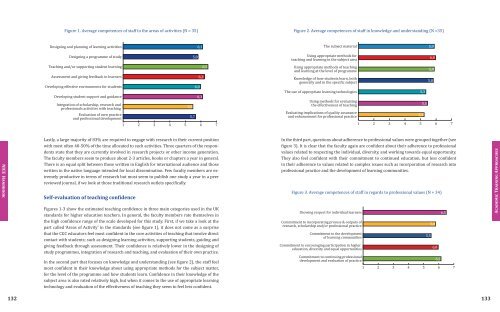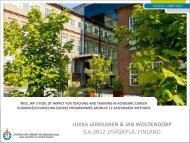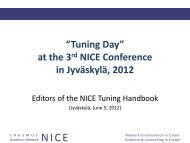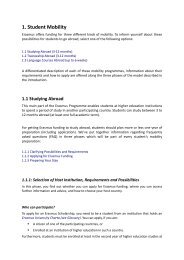NICE HANDBOOK â Academic training of Career ... - Nice-network.eu
NICE HANDBOOK â Academic training of Career ... - Nice-network.eu
NICE HANDBOOK â Academic training of Career ... - Nice-network.eu
Create successful ePaper yourself
Turn your PDF publications into a flip-book with our unique Google optimized e-Paper software.
Figure 1. Average competences <strong>of</strong> staff in the areas <strong>of</strong> activities (N = 35) Figure 2. Average competences <strong>of</strong> staff in knowledge and understanding (N =35)Designing and planning <strong>of</strong> learning activities6,1The subject material5,9Designing a programme <strong>of</strong> study5,8Using appropriate methods forteaching and learning in the subject area6,0Teaching and/or supporting student learningAssessment and giving feedback to learnersDeveloping effective environments for studentsDeveloping student support and guidanceIntegration <strong>of</strong> scholarship, research andpr<strong>of</strong>essionals activities with teaching5,5Evaluation <strong>of</strong> own practiceand pr<strong>of</strong>essional development5,71 2 3 4 5 6 76,06,26,16,5Using appropriate methods <strong>of</strong> teachingand learning at the level <strong>of</strong> programmeKnowledge <strong>of</strong> how students learn, bothgenerally and in the speciic subjectThe use <strong>of</strong> appropriate learning technologiesUsing methods for evaluatingthe effectiveness <strong>of</strong> teachingEvaluating implications <strong>of</strong> quality assuranceand enhancement for pr<strong>of</strong>essional practice5,35,25,55,95,81 2 3 4 5 6 7<strong>NICE</strong> HandbookLastly, a large majority <strong>of</strong> 83% are required to engage with research in their current positionwith most <strong>of</strong>ten 40-50% <strong>of</strong> the time allocated to such activities. Three quarters <strong>of</strong> the respondentsstate that they are currently involved in research projects or other income generation.The faculty members seem to produce about 2-3 articles, books or chapters a year in general.There is an equal split between those written in English for international audience and thosewritten in the native language intended for local dissemination. Few faculty members are extremelyproductive in terms <strong>of</strong> research but most seem to publish one study a year in a peerreviewed journal, if we look at those traditional research outlets specifically.Self-evaluation <strong>of</strong> teaching confidenceFigures 1-3 show the estimated teaching confidence in three main categories used in the UKstandards for higher education teachers. In general, the faculty members rate themselves inthe high confidence range <strong>of</strong> the scale developed for this study. First, if we take a look at thepart called ‘Areas <strong>of</strong> Activity’ in the standards (see figure 1), it does not come as a surprisethat the CGC educators feel most confident in the core activities <strong>of</strong> teaching that involve directcontact with students; such as designing learning activities, supporting students, guiding andgiving feedback through assessment. Their confidence is relatively lower in the designing <strong>of</strong>study programmes, integration <strong>of</strong> research and teaching, and evaluation <strong>of</strong> their own practice.In the second part that focuses on knowledge and understanding (see figure 2), the staff feelmost confident in their knowledge about using appropriate methods for the subject matter,for the level <strong>of</strong> the programme and how students learn. Confidence in their knowledge <strong>of</strong> thesubject area is also rated relatively high, but when it comes to the use <strong>of</strong> appropriate learningtechnology and evaluation <strong>of</strong> the effectiveness <strong>of</strong> teaching they seem to feel less confident.In the third part, questions about adherence to pr<strong>of</strong>essional values were grouped together (seefigure 3). It is clear that the faculty again are confident about their adherence to pr<strong>of</strong>essionalvalues related to respecting the individual, diversity, and working towards equal opportunity.They also feel confident with their commitment to continued education, but less confidentin their adherence to values related to complex issues such as incorporation <strong>of</strong> research intopr<strong>of</strong>essional practice and the development <strong>of</strong> learning communities.Figure 3. Average competences <strong>of</strong> staff in regards to pr<strong>of</strong>essional values (N = 34)Showing respect for individual learners 6,5Commitment to incorporating process & outputs <strong>of</strong>research, scholarship and/or pr<strong>of</strong>essional practiceCommitment to the development<strong>of</strong> learning communitiesCommitment to encouraging participation in highereducation, diversity and equal opportunitiesCommitment to continuing pr<strong>of</strong>essionaldevelopment and evaluation <strong>of</strong> practice5,55,86,06,21 2 3 4 5 6 7<strong>Academic</strong> Training Approaches132 133






